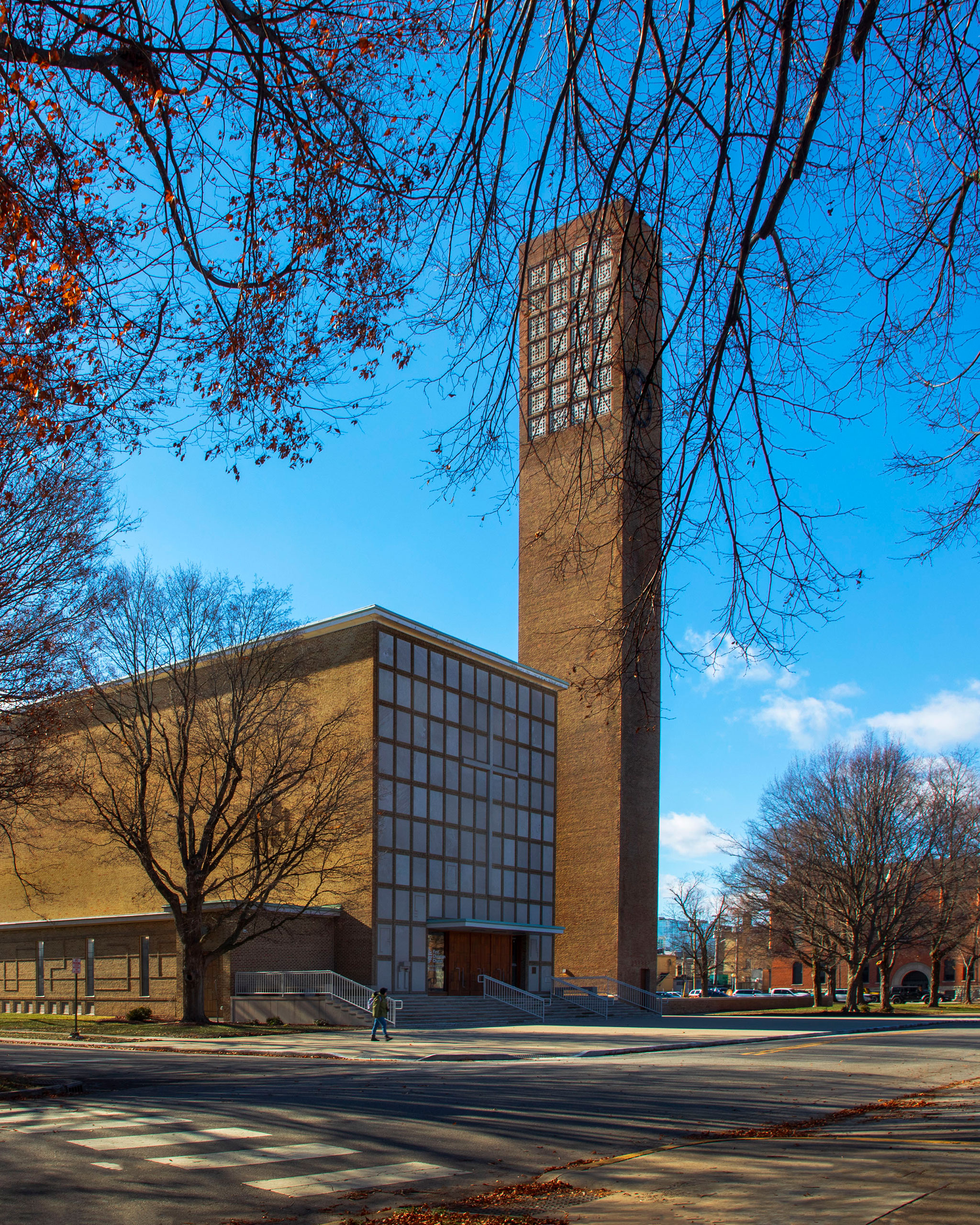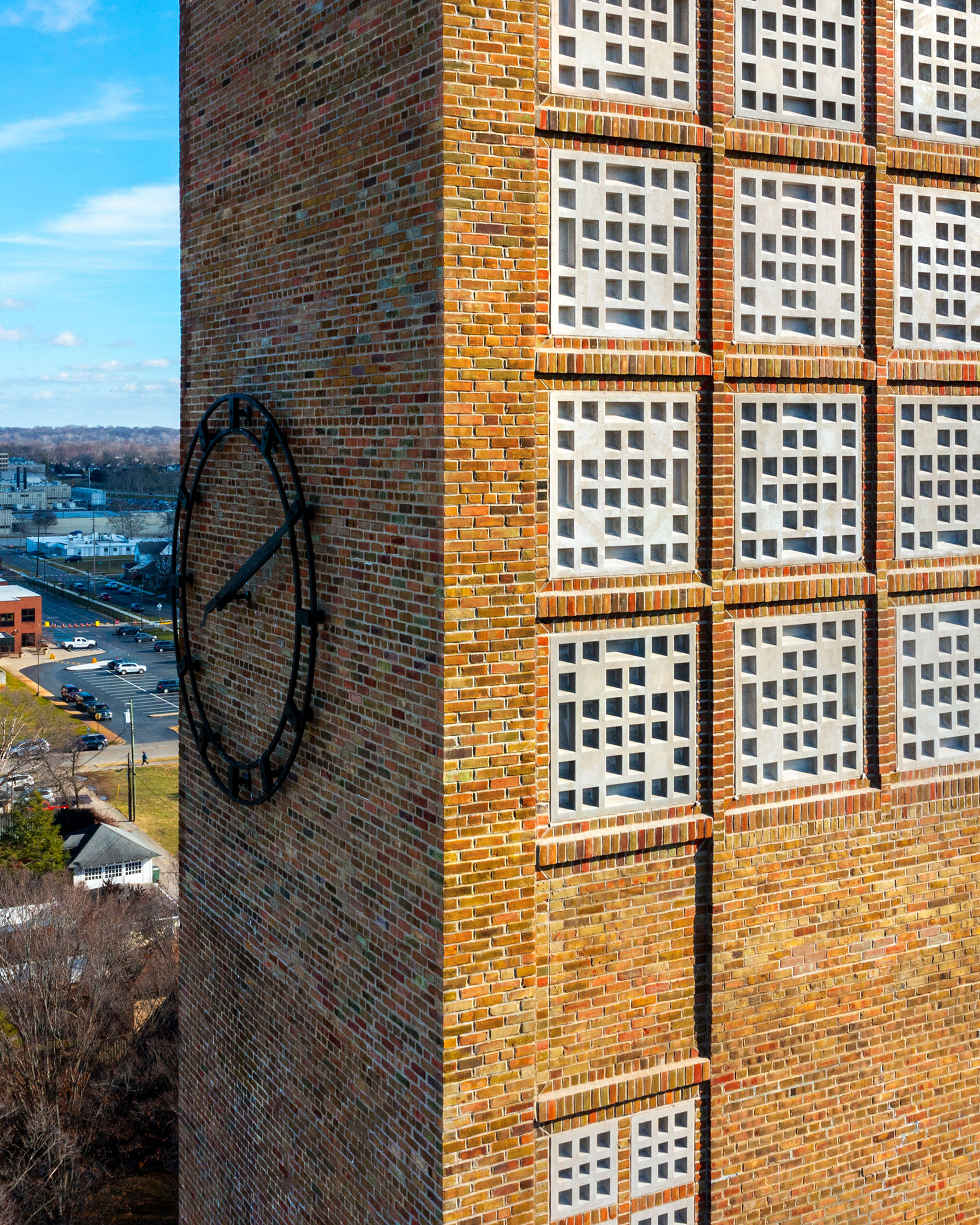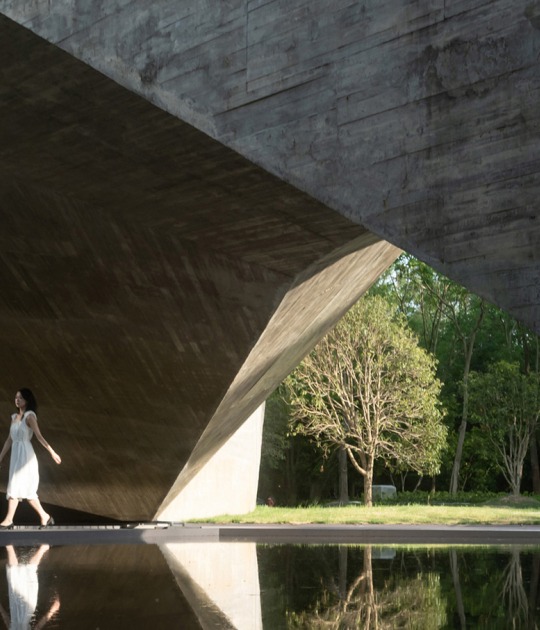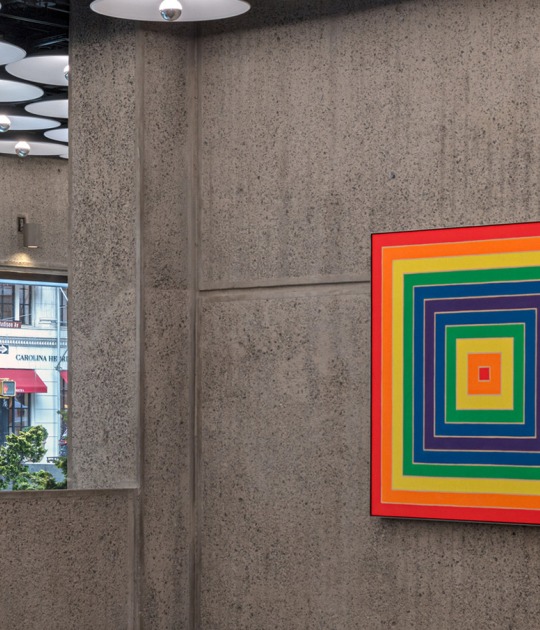At the same time, the damaged concrete and brick were repaired, and the steel elements rusted due to water leaks were replaced, caused by the replacement, in previous interventions, of the original grilles with plastic panels that impeded ventilation. Repair of the cracks and limestone was also carried out; replacing bricks, the cistern pump, and the roof membrane; and the restoration of the Saarinen wooden door.
The intervention was able to be developed due to contributions to the Save Our Tower campaign from individuals and grants from the Jeffris Family Foundation, Save America's Treasures, and the National Park Service.
 Save Our Tower by Louis Joyner Architect. Photography by Hadley Fruits.
Save Our Tower by Louis Joyner Architect. Photography by Hadley Fruits.
Description of project by Louis Joyner Architect
In November 2023 in Columbus, Indiana, the congregation of First Christian Church, the community of Columbus, and supporters from around the country celebrated the completion of the first comprehensive restoration of the Church’s iconic tower. With a musical ceremony, held in the Church’s sanctuary, that honored towers around the world, including the Eiffel Tower, London Bridge Tower, the Leaning Tower of Pisa and Rapunzel’s Tower, First Christian leadership thanked the congregation and all of those who supported the $3.2-million, eight-month restoration project, which began in 2022 and was completed in December 2023.
First Christian Church, designed by Eliel and Eero Saarinen and completed in 1942, is one of the great works of American architecture from the first half of the 20th century. It is widely considered the first Modernist church in America and was designated a National Historic Landmark in 2000. The building illustrates the Saarinens’ genius in building composition and urban design. The relationship of the building to its tower and the site’s open space, as well as how the total work relates to the surrounding urban fabric, are among the structure’s strongest points.
The tower is a 166-foot-high freestanding structure with six levels above grade, a basement, and a cistern in a sub-basement. It is a mass-masonry structure; the walls are entirely brick (29” thick at the base and step back to 17” thick on the highest level). Floors are concrete with steel angle supports. The upper portion of the tower is the clock chamber, whose east and west faces are made up of a grid of four-foot square openings. Originally infilled with precast concrete grilles, they were later replaced with plastic panels. A series of similar four-foot square openings run vertically on the west side.
In 2014, at the request of the Trustees of the Church, Louis Joyner Architect (LJA) with LJ Engineering and The Engineering Collaborative (TEC) prepared a condition report for the entire First Christian Church campus. This report identified the tower as the largest and most complex of the items requiring attention. Among the problems noted in the report were extensive masonry cracking, excessive amounts of water in the interior, and extensive rust throughout. Evidence of prior repairs pointed to a history of problems in the past.

Save Our Tower by Louis Joyner Architect. Photography by Hadley Fruits.
In 2018, alarming cracks in the tower were observed that appeared to be new or expanding, resulting in a new assessment presented to the Trustees in February 2019, that called for a restoration scope of four major parts; stabilization and repair of the upper 50 feet (the “Clock Chamber” level); reconstruction of the “Zipper”; interior repairs; and ventilation and water vapor control. LJA oversaw the work with Ratio Architects (preservation consultants), Arsee Engineers (structural engineer), The Engineering Collaborative (MEP), and F.A. Wilhelm Construction Co. (general contractor).
First, the grid of openings on the east and west faces of the upper portions of the tower was originally infilled with precast concrete grilles. Unfortunately, the design permitted movement, which created extensive cracking on all four walls. This led to water infiltration, which resulted in even more masonry damage and extensive rust. Stabilization and repair of the upper 50 feet (the “Clock Chamber” level) involved removing the east and west walls, removing the brick veneer on the north and south faces, and dismantling the parapets. The east and west sides were reconstructed with a concrete block backup that gives this area the rigidity it lacked. The plastic panels were replaced with Indiana limestone carved in the original grilles’ patterns. Limestone was selected because it looks similar to the original concrete but is much more durable. Cracks in the remaining brick walls were extensively repaired, and the veneer was reinstalled.
Second, the “Zipper” is the stack of 20 openings on the west side of the tower that were also originally infilled with concrete grilles, which may have caused early cracking. At some point, probably around 1960, this was addressed with a concrete “patch” that securely ties the north and west walls. The structural repair was effective, but all the lintels and spandrels were badly damaged from moisture infiltration and were replaced. The new work included the reconstruction of the lintels and the installation of new limestone panels matching the original design (different from the clock chamber grid panels).
On the interior, water and water vapor damaged the brick and all steel items in the structure. Brick and concrete were spalling and were repaired. Rusting ladders and other steel items have been replaced.

Save Our Tower by Louis Joyner Architect. Photography by Hadley Fruits.
And, finally, the original concrete grilles allowed extensive ventilation that permitted the tower to breathe. With the infilling of the “Zipper” and installation of the plastic panels, water vapor could not escape and led to the damage noted above. It was exacerbated by evaporation from an unsealed cistern at the lowest level. The situation was bad enough that it seemed like it had been raining indoors. This required a powerful ventilation system with a new intake and fan. Supplemental heat is being used at times when condensation is most likely. And the cistern has been sealed.
Some of the other work this project addressed includes miles of crack repair; thousands of cracked or spalled bricks replaced; cleaning and tuckpointing; limestone repair; restoration of the clock; new lighting; cistern pump replacement; restoration of Saarinen’s complicated wood door; and replacement of the roof membrane.
First Christian, like most of Eliel Saarinen’s American buildings, is clad with “Cranbrook Buckskin Blend” brick, which has long been unavailable. No brick was found that could match the size, texture, and color range of the original, so the architects settled for one that met two of the three criteria: size and texture. The brick was stained to match Saarinen’s blend.
The project was overseen by a partnership between First Christian Church, Columbus’s Heritage Fund, and Landmark Columbus Foundation. Funds for this project were raised both locally and out of town through the Save Our Tower campaign and then matched in a grant agreement by the Jeffris Family Foundation, which assists in the development of historic sites for nonprofit organizations in several small towns and cities in the Midwest. The Jeffris Family Foundation cited the project’s exceptional planning and leadership in offering this grant. Other funding for the project also has included a $500,000 Save America’s Treasures grant in the amount of $500,000 from the National Park Service and a $250,000 grant from the National Fund for Sacred Places.
Many donors in Indiana and beyond contributed significantly to the project, including John and Sarah Lechleiter, Rick and Alice Johnson, Anthony Moravec, the Irwin Financial Foundation, and the Miller Family.

Save Our Tower by Louis Joyner Architect. Photography by Hadley Fruits.
Tracy Souza, president and CEO of Heritage Fund, said about 70 donors provided donations over the 19 months to enable the matching funds.
Landmark Columbus Foundation cares for, celebrates, and advances the cultural heritage of Columbus, Indiana. To fulfill its mission Landmark Columbus Foundation directs three locally engaged and globally connected programs that are interwoven in their impact and networks: Landmark Columbus, Exhibit Columbus, and Columbus Design Institute.
About Heritage Fund
Heritage Fund was formed in 1976 as a community foundation to continue a legacy of giving by providing an opportunity for all citizens to make gifts and establish charitable funds to benefit the local community. Our mission is to inspire generosity; gather and grow community leaders; and act to ensure that Bartholomew County is an exceptional place for all to live, learn, work, and play.




















































